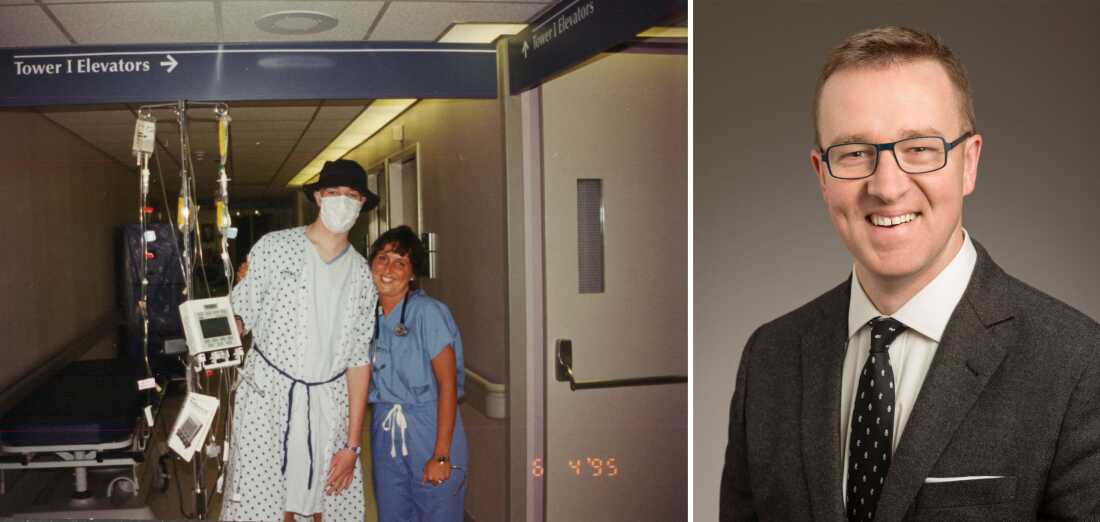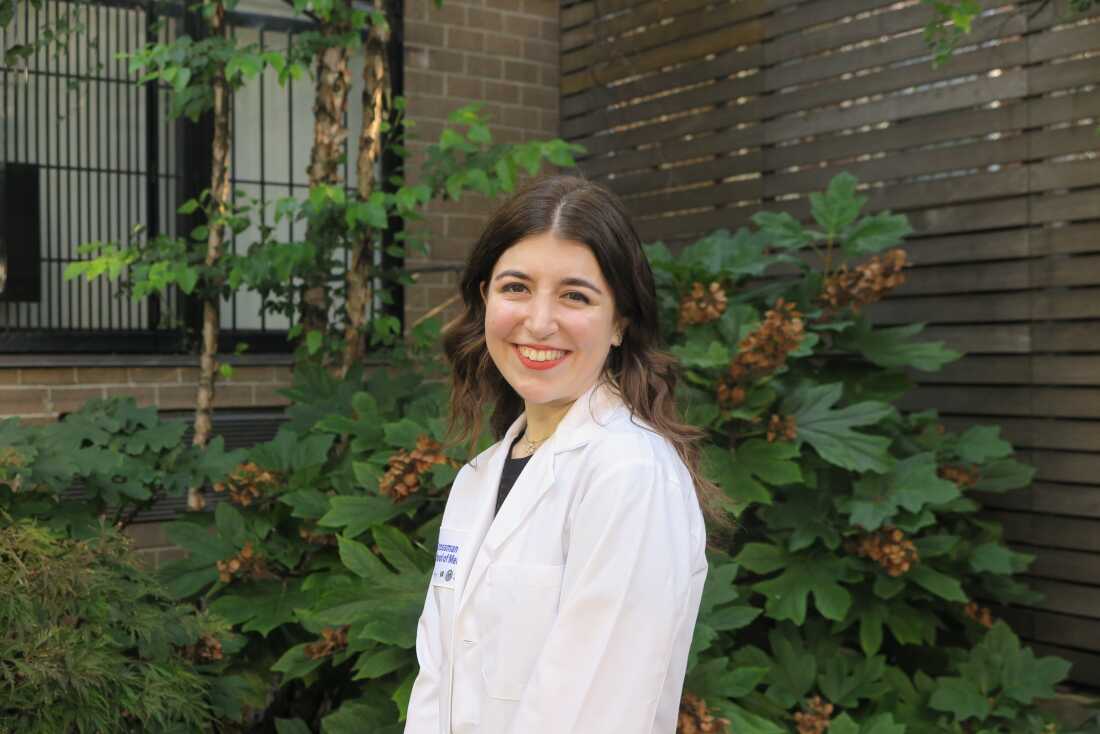At age 8 in 2009, EJ Beck hugs her favorite book, Laura Ingalls Wilder’s These Happy Golden Years. At 10, center, she is pictured in the hospital where she was treated for thyroid cancer. For Beck and her family, the Happy Golden Years image became emblematic of her life, before. At right, EJ Beck today is a 23-year-old medical student.
Beck family; José A. Alvarado Jr. for NPR
hide caption
toggle caption
Beck family; José A. Alvarado Jr. for NPR
EJ Beck was a bookish, wispy 10-year-old when a doctor found the thyroid cancer on her tiny neck that upended her life. Treatment for that cancer took Beck’s joyful school routine and replaced it with a complicated surgery, followed by a harrowing radiation treatment that made her so sick and radioactive, it required her to remain in a sealed chamber without human contact for many days.
Beck, along with her parents, had decided not to tell friends, her teachers or even her two younger sisters about her illness, hoping that might help her slip back into normal life, eventually. But in the short term, it intensified her isolation in the hospital, where she passed her solitary confinement rereading the Harry Potter series and drawing on a picture of Spiderman posted to the window.
“I was so, so jealous because Spiderman could just leave the hospital, and I couldn’t,” Beck recalls. “Spiderman got to take radiation, and he got cool powers; I got sick and sad and lonely and tired.”
Today, Beck is a 23-year-old medical student, and among a growing population of 18 million people who are surviving cancer for much longer, thanks to myriad recent advances like AI-powered tumor detection and new immunotherapies that chemically target cancers. Survival rates for pediatric cancer, in particular, are considered a crowning medical achievement: Those rates increased from 58% in the mid-1970s to 85% today.
But in order to get on with life after treatment, Beck also had to overcome many of the less-discussed aftereffects of cancer – notably the missed schooling and loss of identity and peer support that came with it, not to mention various other cognitive and physical impacts of treatment that deeply shape survivorship. Patients often feel forgotten when treatment ends, but research shows the knock-on effects, from mental health to financial challenges, can persist decades into recovery.
Out of step with peers
Today Beck is cancer-free, but says she still feels she lives in its shadow – quite literally, in the sense that her apartment is within earshot of the sirens near the New York City hospital complex where she received treatment as a child.
Also, the experience forged her into who she is, she says, and left her feeling scholastically, socially, and emotionally out of step with peers. “It takes a really long time to feel like you’re falling into sync with everybody else,” Beck says. “Even if you would make it on to college with everyone else, you kind of feel like you’re marching to a slightly different beat and you’re trying really hard to keep up.”

For many years, EJ Beck’s mother silently carried a golden ribbon that she received from the hospital to advocate for pediatric cancer awareness. “She passed the ribbon on to me,” says Beck, who has that ribbon hanging above her desk at home.
José A. Alvarado Jr. for NPR
hide caption
toggle caption
José A. Alvarado Jr. for NPR
When a child is diagnosed and undergoing treatment, doctors and parents tend to pour their energies – understandably – into managing the medical demands of pediatric cancer. But Julia Gomez, an education coordinator at NYU Langone Health, says for kids, the absence of the normalcy of school usually hits harder. “It’s quite devastating, to the whole child,” she says. “School is their whole world.”
With the increase in the population of survivors, there’s growing recognition that cancer care must also include planning for various aspects of life after treatment. And Gomez says more cancer centers, especially at research hospitals, are hiring education coordinators like her, who can help patients and their families stay connected to school during treatment and transition them back into their lives afterward.
Consistent support
Gomez works with some patients for up to five years, helping them and their families navigate the dizzying number of school or state bureaucracies to ensure students receive home tutoring or additional accommodations, for example. She matches them with tutors in the hospital or at home, and keeps teachers at school updated with treatment plans – tasks parents are often too overwhelmed to manage.
“I can offer myself to take on the whole academic-education-school piece,” she says.
Patient advocates argue specialized wraparound care like education coordinators should be an essential part of all pediatric and young adult cancer treatment plans. But they realistically are only accessible to a privileged minority of patients who live near the research hospitals or cancer centers that offer them.
Aside from those outside services, family engagement and support can have huge bearing on how children fare through treatment and survivorship, says Dr. Saro Armenian, director of the Childhood, Adolescent and Young Adult Survivorship Program at City of Hope Children’s Cancer Center in Los Angeles.
The more consistent, positive support a child feels from the adults and schools around them, the better they will maintain their self-worth through the grueling times, Armenian says. “The social network plays a huge role, especially as a child, when you really don’t have a guidepost for how you should behave and act in that situation.”
But even when children can remain in class or reintegrate back into school, they often feel marked by disease.
EJ Beck, for example, typically only missed morning classes through most of her treatments, but her highly restrictive, iodine-free diet meant she couldn’t eat school lunch, making her a conspicuous target for classmates. “I had this girl — I’ll never forget it,” Beck recalls, “she’d come up to me and say, ‘You’re really bullying everyone else because you’re so skinny and you’re dieting, so you’re saying that the rest of us are fat.'”
Beck swallowed her explanation to keep her cancer secret: “Once people know, they never look at you the same way.”
Still, she felt lucky, because she didn’t lose her hair — that telltale, dreaded side effect — which meant keeping cancer secret was an option for her. “I had the privilege of somebody who…cancer was never going to be as visible on me as it is on the majority of cancer patients.”
An abrupt departure from normalcy
Brendan Harley’s exit from school was far more dramatic and noticeable. On the evening of May 5, 1995 – the night before his SAT exams – Harley landed in the hospital with acute leukemia at age 17.

Brendan Harley home from the hospital in September 1995 after receiving a bone marrow transplant to treat his leukemia. “I was effectively living in a bubble at home,” Harley says.
Harley family
hide caption
toggle caption
Harley family
“I had to call my date for the junior prom, which was the next weekend, and say, ‘Sorry, I’m not going to be there’ – and I was then gone,” he says. He remained in the hospital, in treatment, or in isolation and away from school and friends, for a full year. Notably, this was in an era before cell phones and social media existed, so Harley’s isolation felt complete.
“I was effectively living in a bubble at home,” Harley says. His middle brother helped ferry homework to and from school. “I’d have a tutor that showed up once a week and we would set masks and gloves on different sides of the room and talk.”
It helped Harley to keep pinning his thoughts to discrete school assignments and other tasks he could control. Bald and tired, Harley studied frantically from his hospital bed, clinging to schoolwork as a handhold on life.
Often, things didn’t go to plan, as was the case with his chemistry finals: “I got out and went right to take my exams in June and I couldn’t remember any of the things I was studying because of all the chemotherapy.”

On May 5, 1995, at age 17, Brendan Harley was diagnosed with leukemia. The following day, he started chemotherapy treatments and spent a month on the oncology floor recovering at Brigham and Women’s Hospital in Boston. Now, as a biochemical engineer at the University of Illinois Urbana-Champaign, he’s developing better tumor models that improve targeted treatments
Harley family
hide caption
toggle caption
Harley family
But, says Harley, returning home after feeling so vulnerable made him more determined to live, fully. Driving home from the hospital with the trees having reached full bloom in his absence, he appreciated the vibrancy of color with fresh eyes – and saw his own life in the same light. “It was like I saw it for the first time; I’ve made it back,” he says. “To this day, I can’t forget.”
Vocations forged by experience
Three decades later, Harley’s cancer-free and a father of two. He now fights cancer on a different front. As a biochemical engineer at the University of Illinois Urbana-Champaign, he’s developing better tumor models that help improve targeted treatments to both kill cancer and improve the quality of life afterward. Harley says the cause of his own leukemia may be the earlier radiation and chemotherapy treatments he received at age 1, when he was diagnosed with a neuroblastoma. “How can I make it so that the next generation goes through something different?” he says of his career in cancer research.
Personalizing treatments can help avoid some of the harsher alternatives. “This idea of taking cells from a patient and turning them into a cure…that’s something that is incredibly motivating,” he says.
Meanwhile, EJ Beck is on her own revenge tour against cancer. This fall, she started medical school at NYU Langone, the very hospital where she’d received treatment as a 10 year old. Walking through the same doors as a physician in training felt like the bookend that made her whole life story make sense. “I almost feel like I can see the younger version of myself standing next to me in such a different place in her life,” Beck says.

EJ Beck is now pursuing a medical degree at the same hospital complex where she received treatment as a child. “Sometimes it feels as though I’ve lived lifetimes since then, and it hurts to think about,” she says “But mostly they just make me feel immense gratitude for where I am now – I’m incredibly blessed.”
Beck family
hide caption
toggle caption
Beck family
What cancer stole from her childhood, she’s now reclaiming. “It was extremely identity-forming to me. It helped me understand people’s pain more and gave me a mission that I’ve carried with me in life to become a physician who gives back to a field that’s given me so much.”
Original photography by José A. Alvarado Jr. Visuals design and editing by Katie Hayes Luke.
Audio and digital story edited by Diane Webber.

